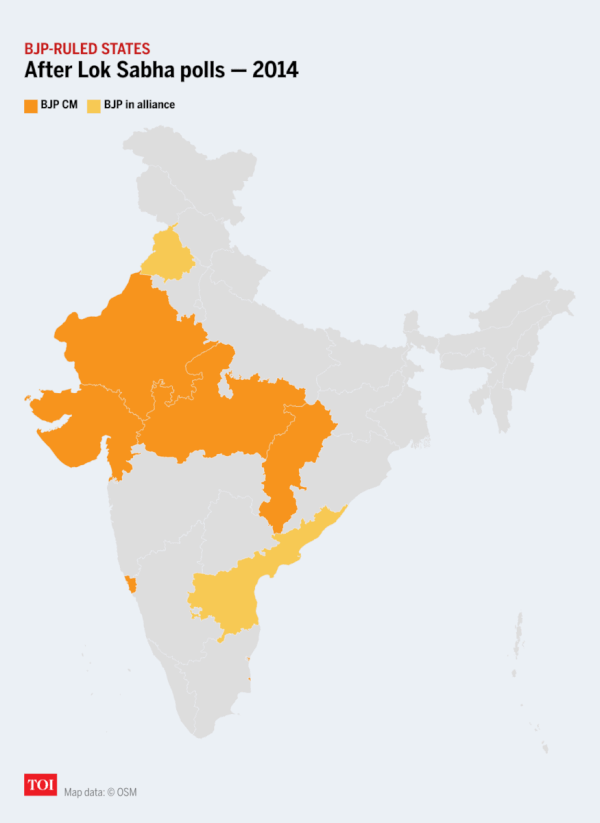While the “Modi era” in Indian politics can be analyzed across several metrics, the one that particularly stands out is the electoral success of the BJP after 2014.
Nine years since Prime Minister Modi took office, the BJP has maintained its dominance in national and state elections, although it has seen some lows here and there.
From 7 to 15

When the Modi government first came to power in 2014, there were BJP governments in 7 states. In 5 states (Gujarat, Rajasthan, Madhya Pradesh, Chhattisgarh and Goa), there was a Chief Minister of BJP. In Andhra Pradesh and Punjab, the party was the junior ally of the NDA government.
Today, the number of states/UTs of the BJP has increased to 15. The party is ruling alone or part of ruling alliance in Uttar Pradesh, Maharashtra, Madhya Pradesh, Gujarat, Haryana, Uttarakhand, Assam, Tripura, Arunachal Pradesh, Goa, Manipur, Meghalaya, Nagaland, Sikkim and Puducherry.
Pulse in 2018
The party’s state tally recorded a magnificent high in March 2018, when the BJP was in power in as many as 22 states across India. This was just after the elections in the northeastern states of Tripura, Meghalaya and Nagaland.
The map above shows the massive footprint of the BJP in the north, east and west parts of the country in 2018. The political landscape, however, changed a few months later when the Congress defeated the BJP in the central states of Madhya Pradesh, Rajasthan and Chhattisgarh.
The increase
The BJP’s electoral conquest could not have been complete without the addition of Uttar Pradesh, India’s most politically crucial state.
Three years after BJP won mandate in UP during Lok Sabha elections (it captured 71 out of 80 constituencies in the state), Saffron Party followed it with impressive victory in state elections.
Credit for the BJP’s 2017 victory in the UP went solely to Prime Minister Modi, as he led the party’s campaign front and centre. In 2022, the BJP once again held power in the state, further solidifying Prime Minister Modi’s popularity.
Saffron Citadel in the northeast
The most notable addition to the BJP’s kitty of states has been the entire northeastern region. In the map it can be seen that the party had no presence here before 2014. However, today it is part of the government in all eight states except Manipur.
The BJP’s rise to prominence in the northeast began after the 2016 elections in Assam, just two years after Prime Minister Modi came to power. Subsequently, he wrested Tripura from leftist rule and forged key alliances in states like Sikkim, Nagaland, Meghalaya and Manipur.
Southern challenge and some setbacks
While it has been a glorious run for the BJP over the past nine years, there have also been some setbacks.
The biggest setback for the BJP came in 2018, when it lost three states at once in Congress. Since then, the BJP has managed to wrest Madhya Pradesh away from the grand old party. However, the party will have to seize power in states like Chhattisgarh and Rajasthan to regain control of the heartland.
Aside from that, power has eluded the party in the southern states. In 2023, it lost its only southern citadel after a poor performance in Karnataka.
Unlike West Bengal and Odisha, where the BJP has emerged as a tough challenger to ruling parties over the years, it remains on the political fringes in states like Kerala, Tamil Nadu and Andhra Pradesh.
However, in 2023, it hopes to make big gains in Telangana with the hope that it can provide the much-needed boost to its prospects in the region.
